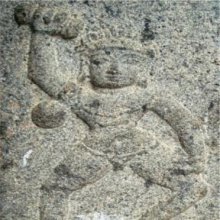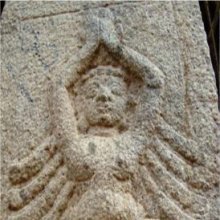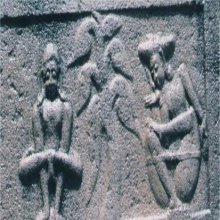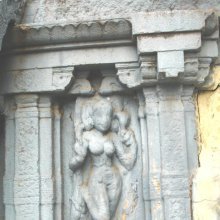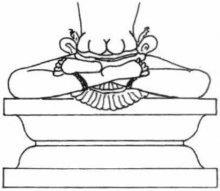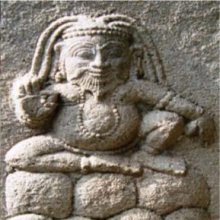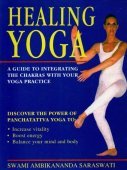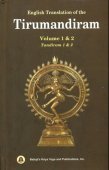Posture: 3 definitions
Introduction:
Posture means something in Buddhism, Pali, Hinduism, Sanskrit. If you want to know the exact meaning, history, etymology or English translation of this term then check out the descriptions on this page. Add your comment or reference to a book if you want to contribute to this summary article.
Images (photo gallery)
(+184 more images available)
In Hinduism
Natyashastra (theatrics and dramaturgy)
Source: Shodhganga: Elements of Art and Architecture in the Trtiyakhanda of the Visnudharmottarapurana (natya)Postures and Gestures (in the path of acting) (in Indian Dramas) are exhibited through Āṅgikābhinaya, which represents one of the four divisions of Abhinaya or “ways to convey or represent one’s emotion to others” (in Sanskrit Drama), according to the Viṣṇudharmottarapurāṇa, an ancient Sanskrit text which (being encyclopedic in nature) deals with a variety of cultural topics such as arts, architecture, music, grammar and astronomy.—Abhinaya (“acting”) is of four varieties, according to the Viṣṇudharmottarapurāṇa. The āṅgikābhinaya represents the physical movements. In Drama characters are projected through their postures. So, various postures connected to sitting, standing and lying down positions always convey certain amount of important information to viewers about the dramatic characters. This way a massage is created through a non verbal communication by the actors and it reaches directly to the minds of the viewers.

Natyashastra (नाट्यशास्त्र, nāṭyaśāstra) refers to both the ancient Indian tradition (shastra) of performing arts, (natya—theatrics, drama, dance, music), as well as the name of a Sanskrit work dealing with these subjects. It also teaches the rules for composing Dramatic plays (nataka), construction and performance of Theater, and Poetic works (kavya).
Yoga (school of philosophy)
Source: ORA: Amanaska (king of all yogas): A Critical Edition and Annotated Translation by Jason BirchPostures (in Yoga) are denoted by the Sanskrit term Āsana, according to Vijñānabhikṣu in his sixteenth-century Sāṅkhyasāra verse 6.2-3.—Accordingly: “One who is not capable of Rājayoga, is suitable for Haṭhayoga. In the Yogavāsiṣṭha, Vasiṣṭha was taught thus by Bhusuṇḍa. In Rājayoga, one cultivates gnosis and, in Haṭhayoga, the breathing exercises and postures (āsana). [Both of] them are important. Since they are auxiliaries, one [depends on] the other. They should [both] be practised according to one's capacity”.

Yoga is originally considered a branch of Hindu philosophy (astika), but both ancient and modern Yoga combine the physical, mental and spiritual. Yoga teaches various physical techniques also known as āsanas (postures), used for various purposes (eg., meditation, contemplation, relaxation).
In Buddhism
General definition (in Buddhism)
Source: A Buddhist Library: In This Very LifePostures (i.e., the traditional four postures) (used in any type of meditation) refers to one of the Seven types of Suitability, which should be met in order to create an environment that is supportive of meditation practice.—The fourth cause for developing the controlling faculties is to make sure that suitable conditions are met for insights to unfold. Proper, suitable and appropriate activities can bring about insight knowledge. The seventh and last kind of suitability is that of posture.
Posture here refers to the traditional four postures:
- Sitting,
- Standing,
- Walking and
- Lying down.
In the tradition of Mahasi Sayadaw, vipassana practice is based on sitting and walking. For any type of meditation, once momentum builds, posture does not really matter; any of the four is suitable.
See also (Relevant definitions)
Ends with: Hand gesture, Lying posture, Seated posture, Sitting posture, Standing posture, Yogic posture.
Full-text (+1997): Virasana, Padmasana, Asana, Vajrasana, Bhadrasana, Yogasana, Svastikasana, Kukkutasana, Siddhasana, Krauncasana, Paryanka, Alidha, Sukhasana, Prasarita, Garudasana, Kayotsarga, Standing posture, Brahmasana, Samapada, Akuncita.
Relevant text
Search found 251 books and stories containing Posture; (plurals include: Postures). You can also click to the full overview containing English textual excerpts. Below are direct links for the most relevant articles:
Vishnudharmottara Purana (Art and Architecture) (by Bhagyashree Sarma)
2.3. Standing Postures < [Chapter 3 - Drama and Dance]
1.3. Elements of Drama (d): Dramatic Postures < [Chapter 3 - Drama and Dance]
2.2. Hand Postures (b): Saṃyukta-hasta < [Chapter 3 - Drama and Dance]
Yoga-sutras (Ancient and Modern Interpretations) (by Makarand Gopal Newalkar)
Sūtra 2.46 [Āsana—posture] < [Book II - Sādhana-pāda]
Sūtra 2.47 < [Book II - Sādhana-pāda]
Sūtra 2.29 < [Book II - Sādhana-pāda]
Amarakoshodghatana of Kshirasvamin (study) (by A. Yamuna Devi)
Education (10): Knowledge in Archery < [Chapter 4 - Cultural Aspects]
Yoga-sutras (with Vyasa and Vachaspati Mishra) (by Rama Prasada)
Sūtra 2.46 < [Book 2 - Practice (Sādhana)]
Sūtra 2.47 < [Book 2 - Practice (Sādhana)]
Sūtra 2.49 < [Book 2 - Practice (Sādhana)]
Yoga-sutras (with Bhoja’s Rajamartanda) (by Rajendralala Mitra)
Sūtra 2.46 < [Second Chapter (Sadhana Pada)]
Sūtra 2.48 < [Second Chapter (Sadhana Pada)]
Sūtra 2.49 < [Second Chapter (Sadhana Pada)]
Manasara (English translation) (by Prasanna Kumar Acharya)
Related products
(+1 more products available)
